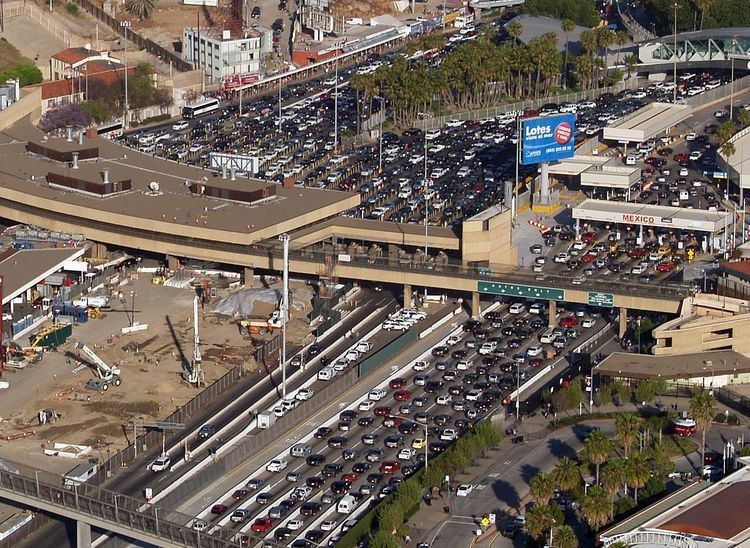Country United States 2015 Cars 14,435,252 2015 Pedestrians 7,056,022 Opened 1906 | Exit Port El Chaparral 2015 Trucks 0 Phone +1 619-690-8900 | |
 | ||
Location 720 East San Ysidro Blvd.
San Diego, CA 92173 Address 720 E San Ysidro Blvd, San Diego, CA 92173, USA Hours Open today · Open 24 hoursMondayOpen 24 hoursTuesdayOpen 24 hoursWednesdayOpen 24 hoursThursdayOpen 24 hoursFridayOpen 24 hoursSaturdayOpen 24 hoursSundayOpen 24 hoursSuggest an edit Similar Garita El Chaparral, Cotton On, San Ysidro Transit Center, Border Station Parking, UETA Duty Free | ||
Crime watch daily the border battle at san ysidro port of entry
The San Ysidro Port of Entry is the largest land border crossing between San Diego and Tijuana. It connects Mexican Federal Highway 1 with Interstate 5 on the U.S. side. The San Ysidro Port of Entry is one of three ports of entry in the San Diego–Tijuana metropolitan region.
Contents
- Crime watch daily the border battle at san ysidro port of entry
- San ysidro port of entry
- History
- San Ysidro Land Port of Entry Expansion Project
- Construction
- El Chaparral Point of Entry
- References
San ysidro port of entry
History
There has been a land border inspection station in the community of San Ysidro since the early 20th century.
Since its beginning, cars, pedestrians and trains were inspected here.
In 1933 the NRHP-listed Old Customs House was built in Mission Revival style, and still stands housing offices. Trucks also once crossed at this location, but in the 1950s, due to congestion, all truck traffic was moved a short distance west to a crossing at Virginia Avenue. Then in 1983, the Otay Mesa Port of Entry was opened and all truck traffic is now inspected there.
The current San Ysidro Land Port of Entry facility was constructed in the 1970s to meet the needs of the time and the projected growth in the coming years. Nearly forty years later, this port of entry has reached its adequate operational capacity and after eight years of planning, it is ready for a major facelift.
With over 90,000 daily commuters crossing between Tijuana and San Diego, commuting has become a challenge for everyday commuters in the metropolitan region; visitors to and from Baja California spend one to three, and as many as five, hours waiting to enter into the United States. U.S. Border and Customs officials have said that newly implemented inspection technology and properly processing the large number of persons and vehicles who go through the port on a daily basis have resulted in long lines and long wait times.
San Ysidro Land Port of Entry Expansion Project
The San Ysidro Land Port of Entry Expansion Project is a bi-national effort between the United States and Mexican governments which aims for the demolition, relocation, expansion, renovation, modernization and construction of new administrative and operational facilities of the current land port of entry in the San Ysidro district of San Diego. The project calls for a complete overhaul of the current international border inspection facilities on both sides of the border at a total cost of about $625 million which includes $577 million for the expansion of the northbound U.S. point of entry and roughly $48 million (MXN $598) for the construction of an entirely new southbound Mexican point of entry.
The project is being carried out in three phases:
Construction
Prior to September 2012, pedestrians walked from the U.S. to Mexico by crossing a pedestrian bridge, entering Mexico to the west of Interstate 5, and walking through a corridor leading to the west side of the crossing (Avenida de la Amistad). Then a temporary pedestrian crossing facility was built on the Mexican side on the east side of the crossing. This was replaced when in August 2015 Mexico inaugurated a new pedestrian crossing facility to the east of the northbound traffic lanes. For the first time foreigners are required to show passports when entering Mexico at the border, whereas previously they only had to be shown when entering the interior of the country.
On July 15, 2016, the PedWest pedestrian crossing and Virginia Avenue transit center were opened, at the east side of the Las Americas outlet mall where Virginia Avenue dead-ends at the border, adjacent to the El Chaparral port of entry into Mexico. On the Mexican side a temporary, partially enclosed walkway was opened connecting this crossing southeastward to the pedestrian bridge from Plaza Viva Tijuana that heads southwest to Downtown Tijuana. This walkway was nicknamed "Puente Chicanadas" ("cheap/quick fix bridge") and characterized by some as dangerous, suffocating and embarrassing to Mexico. In September 2016, a definitive walkway from Plaza Viva Tijuana costing 25 million pesos (about 1.3 million dollars at the time), was opened.
El Chaparral Point of Entry
The southbound lanes of Interstate 5 which take vehicles into Mexico have been moved west of their previous location through the new El Chaparrel Point of Entry (Spanish: Puerta Mexico el Chaparral).). This relocation and expansion was necessary to provide space for the construction of new administrative and border inspection facilities and to increase the number of northbound vehicle lanes. The El Chaparral gateway also has a vehicle and passenger inspection station at which U.S. officials may conduct inspections of southbound traffic, and provides for more thorough inspection of southbound traffic by Mexican officials.
